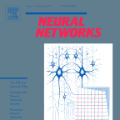Deep neural networks exhibit limited generalizability across images with different entangled domain features and categorical features. Learning generalizable features that can form universal categorical decision boundaries across domains is an interesting and difficult challenge. This problem occurs frequently in medical imaging applications when attempts are made to deploy and improve deep learning models across different image acquisition devices, across acquisition parameters or if some classes are unavailable in new training databases. To address this problem, we propose Mutual Information-based Disentangled Neural Networks (MIDNet), which extract generalizable categorical features to transfer knowledge to unseen categories in a target domain. The proposed MIDNet adopts a semi-supervised learning paradigm to alleviate the dependency on labeled data. This is important for real-world applications where data annotation is time-consuming, costly and requires training and expertise. We extensively evaluate the proposed method on fetal ultrasound datasets for two different image classification tasks where domain features are respectively defined by shadow artifacts and image acquisition devices. Experimental results show that the proposed method outperforms the state-of-the-art on the classification of unseen categories in a target domain with sparsely labeled training data.
翻译:深神经网络在具有不同缠绕的域特征和绝对特征的图像中具有有限的通用性。学习能够形成跨域通用绝对决定界限的通用特征是一个有趣而困难的挑战。当试图在不同图像获取装置、不同获取参数或新培训数据库中缺少某些类的深度学习模型时,医疗成像应用中经常出现这一问题。为了解决这个问题,我们提议以相互信息为基础的分解神经网络(MIDNet),它提取出在目标域中将知识转移给不可见类别的可通用的绝对特征。提议的MIDNet采用了一种半监督的学习模式,以减轻对标签数据的依赖。这对于数据注释耗时、费用昂贵、需要培训和专门知识的现实应用十分重要。我们广泛评价了两种不同图像分类任务的胎儿超声波数据集的拟议方法,即域特征分别由影子文物和图像获取装置界定。实验结果显示,拟议的方法超出了目标域中以隐蔽标记培训数据对视视类别分类的状态。





